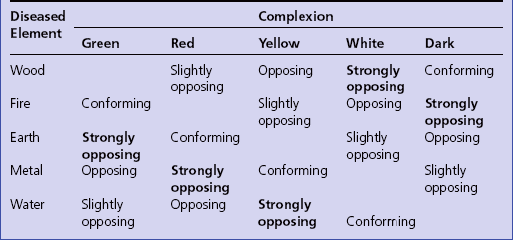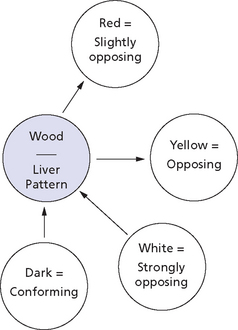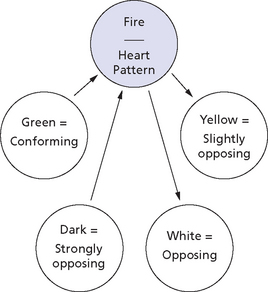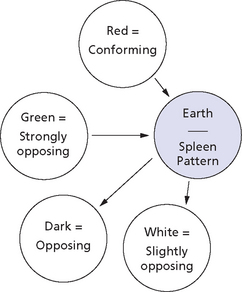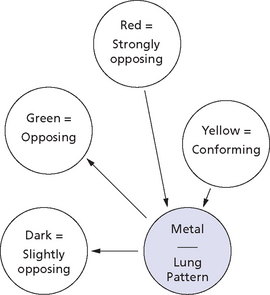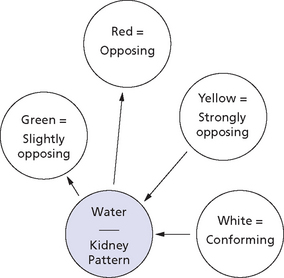 OBSERVATION OF THE COMPLEXION COLOUR
OBSERVATION OF THE COMPLEXION COLOUR
INTRODUCTION
The chapter ‘On observation of the colour’ in ‘Principle and Prohibition for the Medical Profession’ (Yi Men Fa Lu) says: ‘When the five Yin organs are exhausted, the complexion colour becomes dark and lustreless … So the complexion colour is like a flag of the Spirit, and the Yin organs are the residences of the Spirit. When the Spirit is gone, the Yin organs are worn out, and the complexion colour becomes dark and lustreless.’1 As the above passage indicates clearly, observation of complexion colour is a very important diagnostic tool to assess the condition not only of Qi, Blood, Yin and Yang and of the internal organs, but also of the Mind and Spirit. Indeed from a Five-Element perspective, the facial complexion as a whole is a manifestation of the Heart and therefore the Mind and Spirit; this should never be forgotten in practice. Thus, if a woman has a very dull, sallow complexion it does indicate a Spleen-Qi deficiency and Dampness and possibly also Blood deficiency, but, at the same time, it also indicates that the Mind and Spirit are affected and suffering.
Yu Chang in ‘Principles of Medical Practice’ (1658) calls the complexion the ‘banner of the Mind and Spirit’ and he says: ‘When the Mind and Spirit are flourishing, the complexion is glowing; when the Mind and Spirit are declining, the complexion withers. When the Mind is stable the complexion is florid …’.2
The normal complexion should have ‘lustre’ and ‘moisture’. ‘Lustre’ means that the complexion colour should be bright, glowing and with a shine to it; ‘moisture’ means that the complexion should look moist and the skin firm, indicating that there is moisture underneath it. There is a correspondence between these two aspects of the complexion and two of the attributes of the normal pulse: the lustre of the complexion corresponds to the spirit of the pulse, whereas the moisture of the complexion corresponds to Stomach-Qi of the pulse. Thus, we can say that if the complexion has lustre there is spirit; if it has moisture there is Stomach-Qi.
DOMINANT AND GUEST COLOURS
Dominant colours
The normal complexion colour varies, of course, according to racial group but also according to Elemental types as described in Chapter 1. Wood types have a subtle greenish hue to their complexion, Earth types a subtle yellowish hue, Fire types a red hue, Metal types a white hue, and Water types a dark hue.
The basic inherited complexion colours, determined by race and Elemental type, are called ‘dominant colours’. The chapter ‘Keys to the Four Diagnostic Methods’ in the ‘Golden Mirror of Medicine’ (Yi Zong Jin Jian) says: ‘The colours of the five Yin organs manifest in people according to their body shape based on the Five Elements. Such colours never change throughout life. They are known as dominant colours.’3
Chapter 12 of the ‘Simple Questions’ discusses environmental influences on the complexion:
The East is where Qi of all kinds of life in nature starts. It is an area close to seas and water and abounds in fish and salt. People who live in the East eat a lot of fish, and like salty food. Therefore they often have a relatively dark complexion and loose structures between the complexion and muscles. The South is where all kinds of life in nature grow vigorously, and where Yang flourishes. It is lower terrain, and has poor water and soil. There is often fog. People who live in the South like sour-flavoured and fermented food. Therefore, they often have a relatively red complexion and dense structures between the complexion and muscles.4
Box 3.1 summarizes the dominant colour.
Guest colours
Chapter 57 of the ‘Simple Questions’ says:
The Yellow Emperor asks: ‘The Connecting channels are exposed to the exterior and manifest with five different colours which are green, yellow, red, white and black. What is the reason?’ Qi Bo answers, ‘The main channels have their regular colours, but the colours of the Connecting channels change according to the four seasons.’ The Yellow Emperor asks, ‘What are the normal colours of the main channels?’ Qi Bo answers, ‘Red for the Heart, white for the Lungs, green for the Liver, yellow for the Spleen and black for the Kidneys.’ The Yellow Emperor asks, ‘Do the colours of the Yin and Yang Connecting channels correspond to the regular colours of the related main channels?’ Qi Bo answers, ‘The colours of the Yin Connecting channels correspond to the regular colours of their related main channels, while those of the Yang connecting channels change in accordance with the four seasons. In cold weather, the circulation of Qi and Blood slows down and there is often a green or black colour. In warm and hot weather, Qi and Blood circulation is free and smooth, and there is usually a yellow or red colour. All these are normal phenomena, indicating the body is in a normal condition.’5
OBSERVATION OF DIFFERENT ASPECTS OF COMPLEXION COLOUR
The main aspects of complexion colour to observe are:
Superficial or deep colour
Observation
The differentiation between superficial and deep colour is based on the ‘depth’ of the complexion’s colour. A colour is defined as ‘superficial’ (see Plate 3.1 on p. P2) when it is seen clearly on the surface of the complexion, while it is defined as ‘deep’ when it appears to be on a level below the surface (see Plate 3.2 on p. P3).
Chapter 49 of the ‘Spiritual Axis’ says: ‘The five colours are present in certain areas of the face. Recognizing whether the colours are superficial or deep helps us to understand the shallow or deep location of the pathogenic factors.’6 The chapter ‘Keys to the Four Diagnostic Methods’ in the ‘Golden Mirror of Medicine’ (Yi Zong Jin Jian) says:
The deep colour is relatively dark. It indicates that diseases are deep in the Interior. If it is also obscure and lustreless, it indicates that diseases are chronic and severe. The superficial colour is relatively light. It indicates that diseases are on the Exterior. If it is also bright and lustrous, it indicates that diseases are mild and newly-occurring.’7
The chapter ‘Outline of the Ten Methods for Recognizing Qi’ of ‘Wang Zhen Zun Jing’ says:
‘The superficial colour is shown on the complexion, while the deep colour is hidden underneath the complexion. The superficial colour indicates Exterior diseases, and the deep colour indicates Interior diseases. If the colour is first superficial and later becomes deep, it reveals the movement of a disease from the Exterior to the Interior. If the colour is first deep and later becomes superficial, it reflects the movement of the disease from the Interior to the Exterior.’8
Clinical significance
Chapter 15 of the ‘Simple Questions’ says:
If there are changes of the colours in the upper, lower, left and right regions of the face, efforts should be made to understand the location and prognosis of the diseases indicated by the respective colours. If the abnormal colour is light, it implies that the diseases are mild. Such patients can be treated with soups to nourish the body. They will recover in 10 days. If the abnormal colour is deep, it indicates that the disease is severe. Such patients should be treated with a herbal decoction. They will recover in 21 days. If the abnormal colour is even deeper, it means that the disease is much more severe. They must be treated with a herbal tincture to regulate the circulation in the channels. They will recover in 100 days. If the colour of the complexion is dark, haggard, vigourless and emaciated, it shows that the Spirit is gone, the disease cannot be treated and such patients will die in 100 days.9
Box 3.3 summarizes superficial and deep colour.
Distinct or obscure colour
Observation
The differentiation between a ‘distinct’ or ‘obscure’ colour refers to the quality of the complexion colour: a distinct colour is bright and clear and manifests itself readily while an obscure colour is darkish, dull and lifeless as if ‘trapped’ inside the complexion. It is important to note that the differentiation between the distinct colour and the obscure colour of the complexion applies to any shade of pathological colour and both the distinct and obscure colours are abnormal; for example, a pathological, dull, yellow complexion may be either ‘distinct’ or ‘obscure’ (see Plates 3.3 and 3.4 on p. P3).
The chapter ‘Outline of Ten Methods for Recognizing Qi’ of ‘Wang Zhen Zun Jing’ says:
The distinct, bright colour looks unfolded and the dark, obscure colour looks gloomy. The distinct colour indicates that the disease is of the Yang type; the obscure colour indicates that the disease is of the Yin type. If the distinct colour becomes obscure, it means that the disease has changed from the Yang to the Yin type. If the obscure colour becomes distinct, it means that the disease has changed from the Yin to the Yang type.10
Scattered or concentrated colour
Observation
When considering abnormal complexion colours, another differentiation is that between ‘scattered’ and ‘concentrated’. The scattered colour is thinly distributed and sparse, while the concentrated colour is densely distributed and aggregated (see Plates 3.5 and 3.6 on p. P3).
Chapter 49 of the ‘Spiritual Axis’ says: ‘The observation whether the colour is scattered or concentrated tells us whether the disease is a long way off or imminent.’11
The scattered colour is thinly distributed and ‘open’; the concentrated colour is densely distributed and ‘closed’. The scattered colour indicates that the disease has had a short duration, and is about to be alleviated. The concentrated colour indicates that the disease has had a long duration and will gradually become severe. If the abnormal colour is concentrated at first but changes later to being scattered, it indicates that the disease is about to be alleviated even though it has had a long duration. If the abnormal colour is scattered at first but changes later to being concentrated, it indicates that the disease is becoming severe even though it has had a short duration.’12
Thin or thick colour
Observation
The differentiation between a thin colour and a thick colour is based on the ‘thickness’ of the colour. To understand this distinction one could think of paint: the thin colour corresponds to a single skimpy coat of paint while the thick colour corresponds to several heavy coats of paint (see Plates 3.7 and 3.8 on pp. P3 and P4).
Lustrous or lustreless colour
Conforming or opposing colour
Observation
Conforming or opposing colour according to the Five Elements
According to the second aspect, the conforming or opposing complexion colour is also decided on the basis of the Five Elements and one can distinguish four different situations when the complexion does not accord with the prevailing Element pattern. A practical example is the best way of describing these four possible situations. If a patient suffers from a Liver pattern but the complexion reflects the colour of the Mother Element (i.e. Water), this is called ‘conforming colour’; if the complexion reflects the colour of the Child Element (i.e. Fire) this is called the ‘slightly opposing colour’ (Chinese books refer to it as ‘opposition within conformity’); if the complexion reflects the colour of the Element overacted upon (i.e. Earth) this is called ‘opposing colour’ (Chinese books refer to it as ‘conformity within opposition’); if the complexion reflects the colour of the Element overacting on that of the prevailing pattern (i.e. Metal) this is called ‘strongly opposing colour’ (Table 3.1). The last scenario (i.e. when the complexion colour belongs to the Element that overacts on the Element of the prevailing pattern) is the most serious one. For example, if a patient suffers from a severe Spleen-Qi deficiency (Earth) but the complexion is green (Wood), this is a bad sign and it means that the condition will be more difficult to treat.
The conforming and opposing colours for diseases of the Five Elements are illustrated in Figures 3.1–3.5.
Prognosis according to complexion colour
Observation
1. Presence or absence of lustre
If a pathological complexion colour is bright, lustrous and contained, this is a sign of good prognosis; if it is dark, lustreless and fully revealed, it indicates poor prognosis. Shi Pa Nan in the ‘Origin of Medicine’ (1861) says: ‘The shen of the complexion consists in lustre and body. Lustre means that the complexion appears clear and bright from the outside; body means that it is moist and with lustre in the inside.’14 If a complexion has such attributes, even if the colour is pathological, this indicates that the Mind and Spirit are stable and unaffected and therefore the prognosis is good.
Chapter 10 of the ‘Simple Questions’ differentiates between a good prognosis and a poor prognosis by observation of the five main pathological colours, comparing them with various objects that were in common daily use in ancient China (some of which will be unfamiliar to Westerners). The colours are given in Table 3.2.15
Table 3.2
Descriptions of pathological complexion colours in the ‘Simple Questions’
| Pathological colour | Good prognosis | Poor prognosis |
| Green | feather of a kingfisher | dead grass |
| Red | rooster comb | stagnant blood |
| Yellow | abdomen of a crab | bitter orange |
| White | pig’s fat | dead bone |
| Dark | crow’s feathers | coal ash |
The same chapter also describes the five main healthy complexion colours, again comparing them with various objects (Table 3.3).16
Table 3.3
Descriptions of healthy complexion colours in the ‘Simple Questions’
| Organ | Healthy complexion colour |
| Liver | thin piece of white silk covering a dark purple one |
| Heart | thin piece of white silk covering cinnabar |
| Spleen | thin piece of white silk covering snakegourd (Gua Lou) fruit |
| Lungs | thin piece of white silk covering a pink one |
| Kidneys | thin piece of white silk covering a purple one |
Chapter 17 of the ‘Simple Questions’ describes the look of pathological colours with or without lustre in a slightly different way:
A red complexion should look like vermilion covered with white, not like ochre. A white complexion should look like feathers of a goose, not like salt. A blue complexion should look like moistened greyish jade, not like indigo. A yellow complexion should look like realgar covered with gauze, not like loess [the soil in North China along the Yellow River basin]. A black complexion should look like dark varnish, not like greyish charcoal.17
Dr Chen Shi Duo in ‘Secret Records of the Stone Room’ (1687) goes as far as saying: ‘If the complexion is dark but with shen, the person will live even if the disease is serious. If the complexion is bright but without shen, the person will die even if there is no disease.’18
2. Conforming or rebellious colour according to area of the face
The ‘Simple Questions’ in Chapter 15 relates the conforming or rebellious movement of a facial colour (and therefore the prognosis) also to the left or right side of the face, making a distinction according to sex: ‘In women, [a colour] on the right side indicates a rebellious [colour], while on the left side it is conforming. In men, [a colour] on the left side indicates a rebellious [colour], while on the right side it is conforming.’19 This passage correlates the prognosis to the location of a pathological colour on the right or left side of the face in men and women: for example, in a woman, an excessively red colour is always pathological whether it is on the right or left but it is worse if it is on the right cheek; the reverse applies to a man.
4. Conformity or deviation of colour according to season
The Qi of the five Yin organs manifests with the five different [physiological] colours in accordance with the five different types of body shapes. Such colours will never change and are called Dominant Colours. The colours influenced by the climatic factors of the four seasons will change accordingly and are not the same all the time: they are called the Guest Colours. The climate in Spring corresponds to the Liver, and the complexion colour is relatively green. The climate in Summer corresponds to the Heart, and the complexion colour is relatively red. The climate in Autumn corresponds to the Lungs, and the complexion colour is relatively white. The climate in Winter corresponds to the Kidneys, and the complexion colour is relatively dark. The climate in Late Summer corresponds to the Spleen, and the complexion colour is relatively yellow. These colours are seen when the climatic changes in the seasons are normal. The Dominant Colours are a [physiological] manifestation of the five Yin organs, while the Guest Colours are produced by the climatic changes of the seasons. Therefore, [when observing] the complexion colour, if the influence of the climatic factors of the seasons exceeds that of the five Yin organs, it indicates a good prognosis. That is why it is said that the Guest colour replacing the Dominant colours is a sign of good prognosis. If the influence of the five Yin organs exceeds that of the climatic factors of the seasons, it is a sign of poor prognosis. That is why it is said that the Dominant Colours overtaking the Guest Colours is a sign of poor prognosis. The so-called replacing of the colours is found in the following situations: the complexion colour should be green [in Spring] but is white instead; the complexion colour should be red [in Summer] but is black instead; the complexion colour should be white [in Autumn] but is red instead; the complexion colour should be black [in Winter] but is yellow instead; and the complexion colour should be yellow [in Late Summer] but is green instead.20
Box 3.8 summarizes the factors that affect prognosis.
Changes in complexion colour during a disease
Observation
Chapter 49 of the ‘Spiritual Axis’ says:
If the complexion colour looks contained and slightly bright, it indicates that the disease is mild. If the complexion colour is dark and lustreless, it means that the disease is severe. If the abnormal colour moves upwards [in the face], it is a sign of aggravation of the disease. If the abnormal colour moves downwards [in the face], like black clouds dissipating, it is a sign of the gradual alleviation of the disease.21
Complexion colours and emotions
Specific signs in the complexion may indicate various emotions.
Excess joy may manifest with a red colour on the cheekbones.
Pensiveness may manifest with a sallow complexion because it depletes Spleen-Qi.
Hatred often shows with a greenish complexion on the cheeks.
Craving shows with a reddish colour on the cheeks.
Guilt shows with a dark-ruddy complexion.
Box 3.9 summarizes the complexion colours associated with the emotions.
COMPLEXION COLOURS
Normal complexion colour
Observation
The colour of the facial complexion should be ‘contained’ as if there was a very thin, white silk veil over it. The book ‘Wang Zhen Zun Jing’ describes the normal complexion colour as being bright and lustrous and says: ‘The complexion is bright because of the embodiment of the Spirit. It is lustrous because of the nourishment of the Essence and Blood.’22
Apart from racial differences, there can be wide variations in normal complexion in people of the same race due to other factors such as the influence of prenatal constitution, the profession, the area people come from and their working or living environment. However, complexion colour changes caused by the above-mentioned factors are not regarded as abnormal. For example, the normal complexion of a farmer will be rosier and redder than that of an office worker (see Plate 3.9 on p. P4).
Clinical significance
A bright, lustrous, white-reddish and ‘contained’ complexion colour in Caucasian people indicates strong Stomach-Qi, normal Internal Organs, ample Blood and good Spirit. This is regarded as a normal complexion colour. If such a complexion colour is observed in the process of a disease, it means that the duration of the disease is short, the pathogenic factors are weak, the Upright Qi is still strong, the treatment will be easy and the prognosis is good. Chapter 17 of the ‘Simple Questions’ says:
In the course of a disease, if the pulse is small and the complexion colour is normal, it is a disease with a short duration. If the pulse is normal but the complexion colour is abnormal, it is a disease with a long duration. If both the pulse and the complexion colour are abnormal, it is a disease with a long duration. If both the pulse and the complexion colour are normal, it is a disease with a short duration.’23
This highlights the connection between complexion colour and the duration of a disease.
Box 3.10 summarizes the attributes of a normal complexion.
White complexion colour
Symptoms and Signs, Chapter 56
There are several shades of white complexion:
Bright white
Dull white
Pale white
Sallow white
Observation
The sallow-white complexion is dull, without lustre and with a slight hint of yellow (see Plates 3.13 and Plate 3.14 on pp. P4 and P5).
Yellow complexion colour
Symptoms and Signs, Chapters 56 and 68
There are several types of yellow complexion:
Dull yellow
Greyish-yellow
Observation
The greyish-yellow complexion is dull, ashen and without lustre (see Plate 3.16 on p. P5).
Floating yellow
Dry yellow
Ash-like yellow
Observation
The ash-like yellow complexion is dull, darkish and ‘smoky’. It is darker than the greyish-yellow complexion (see Plate 3.19 on p. P5).
Rich yellow
Bright yellow (jaundice)
Observation
Chapter 18 of the ‘Simple Questions’ says: ‘Symptoms such as deep yellow urine and lethargy indicate jaundice… yellow conjunctiva indicates jaundice.’24 Chapter 74 of the ‘Spiritual Axis’ says: ‘If the face is slightly yellow, the teeth filthy yellow, the nails yellow, this indicates jaundice. (If there are also symptoms and signs such as lethargy, deep yellow urine, poor appetite and a Small-Choppy pulse, it then indicates that it is the disease of the Spleen.)’25
Clinical significance
The aetiology of jaundice, manifesting with yellow conjunctiva and a yellow complexion colour, is often related to poor diet and invasion by pathogenic factors such as Damp, Heat and Toxic Heat. It is often located in the Liver, Gall-Bladder, Spleen and Stomach. The nature of the disease is often one of either Damp-Heat, Cold-Damp, Toxic Heat, or Qi and Blood deficiency. Signs and symptoms such as a bright-yellow colour like an orange (called ‘Yang yellow’), a Red tongue with a thick coating, yellow urine and abdominal distension indicate that the disease is caused by the accumulation of Damp-Heat in the Liver, Gall-Bladder, Spleen and Stomach. Signs and symptoms such as a dark-yellow, smoky colour (called ‘Yin yellow’) and a light-Red tongue body with a thick white coating indicate that the disease is caused by Cold-Damp being retained in the Liver, Gall-Bladder, Spleen and Stomach.
Box 3.13 summarizes the types of yellow complexion colour.
Red complexion colour
Symptoms and Signs, Chapter 56
Red cheeks
Observation
In this case, the facial complexion is too red and the redness is located all over the cheeks; in some cases one cheek may be redder than the other. Usually the right cheek reflects the condition of the Lungs whereas the left one reflects the condition of the Liver (see Plates 3.21 and 3.22 on p. P6).
Red cheekbones
Observation
In this case, only the cheekbones are red and the colour is usually ‘thinner’ than that of Full-Heat; the redness of the cheekbones may come and go and often it appears only in the afternoon or evening (see Plates 3.23 and 3.24 on p. P6).
Floating red
Observation
The floating red colour is a ‘thin’, floating, pale red that looks like rouge and may move from place to place (see Plate 3.25 on p. P6).
Bluish/greenish complexion colour
Symptoms and Signs, Chapter 56
‘Bluish/greenish’ is a translation of the Chinese word qing which can mean both blue and green. In the context of the Five Elements, it is the colour associated with Wood and it therefore makes more sense to translate it as green. In the context of facial diagnosis, qing can mean either bluish or greenish; for example, the qing colour may indicate a Liver pattern, in which case it would be greenish, or interior Cold, in which case it would be bluish (see Plate 3.32 on p. P8).
Dark complexion colour
Symptoms and Signs, Chapter 56
There are several types of dark complexion:
Dark and dry
Dull dark
NOTES
1. Cited in Sheng, Zhang Shu. Great Treatise of Diagnosis by Observation in Chinese Medicine (Zhong Hua Yi Xue Wang Zhen Da Quan  ). Taiyuan: Shanxi Science Publishing House, 1995; 82.
). Taiyuan: Shanxi Science Publishing House, 1995; 82.
2. Principles of Medical Practice 1658, cited in Wang Ke Qin 1988 Theory of the Mind in Chinese Medicine (Zhong Yi Shen Zhu Xue Shuo  ), Ancient Chinese Medical Texts Publishing House, p. 56.
), Ancient Chinese Medical Texts Publishing House, p. 56.
3. Cited in Great Treatise of Diagnosis by Observation in Chinese Medicine, p. 82
4. The Yellow Emperor’s Classic of Internal Medicine – Simple Questions (Huang Di Nei Jing Su Wen  ). People’s Health Publishing House: Beijing, 1979:80 First published c. 100BC
). People’s Health Publishing House: Beijing, 1979:80 First published c. 100BC
5. The Yellow Emperor’s Classic of Internal Medicine – Simple Questions (Huang Di Nei Jing Su Wen  ). People’s Health Publishing House: Beijing, 1979; 291.
). People’s Health Publishing House: Beijing, 1979; 291.
6. Spiritual Axis (Ling Shu Jing  ). People’s Health Publishing House: Beijing, 1981:96 First published c. 100BC
). People’s Health Publishing House: Beijing, 1981:96 First published c. 100BC
7. Qian, Wu. Golden Mirror of Medicine (Yi Zong Jin Jian  ); vol. 2. People’s Health Publishing House, Beijing, 1977:872. [First published in 1742].
); vol. 2. People’s Health Publishing House, Beijing, 1977:872. [First published in 1742].
8. Cited in Great Treatise of Diagnosis by Observation in Chinese Medicine, p. 85
10. Cited in Great Treatise of Diagnosis by Observation in Chinese Medicine, p. 85
12. Cited in Great Treatise of Diagnosis by Observation in Chinese Medicine, p. 86
14. Shi Pa Nan 1861 Origin of Medicine (Yi Yuan  ), cited in Wang Ke Qin 1988 Theory of the Mind in Chinese Medicine, p. 55.
), cited in Wang Ke Qin 1988 Theory of the Mind in Chinese Medicine, p. 55.
15. Simple Questions, pp. 71–2.
18. Chen Shi Duo 1687 Secret Records of the Stone Room (Shi Shi Mi Lu  ), cited in Wang Ke Qin 1988 Theory of the Mind in Chinese Medicine, p. 56.
), cited in Wang Ke Qin 1988 Theory of the Mind in Chinese Medicine, p. 56.
20. Golden Mirror of Medicine, vol. 2, pp. 866–867
22. Cited in Zhang Shu Sheng 1995 Great Treatise of Diagnosis by Observation in Chinese Medicine, p. 89

